Final Assessment: HLTWHS004 Manage Work Health and Safety
VerifiedAdded on 2023/04/05
|24
|5802
|435
Homework Assignment
AI Summary
This assignment comprehensively addresses Work Health and Safety (WHS) management within the context of community services. It meticulously examines the impact of state and territory legislation on workplace regulations, codes of practice, and industry standards, including the roles of WHS authorities. The assignment delves into the rights and responsibilities of persons conducting a business or undertaking (PCBUs), officers, and workers, emphasizing the duty of care. It further explores the implications of legislation on due diligence and general duty requirements. Specific regulatory requirements relevant to the community services environment are provided, along with guidelines for raising issues within WHS policies. The assessment also addresses hazardous manual tasks, detailing their characteristics and the influence of legislation on their performance. Furthermore, it outlines the essential components of WHS policies regarding hazard identification, risk assessment, and control, and explains the principles of hazard and risk management, particularly risk analysis, within community services settings.
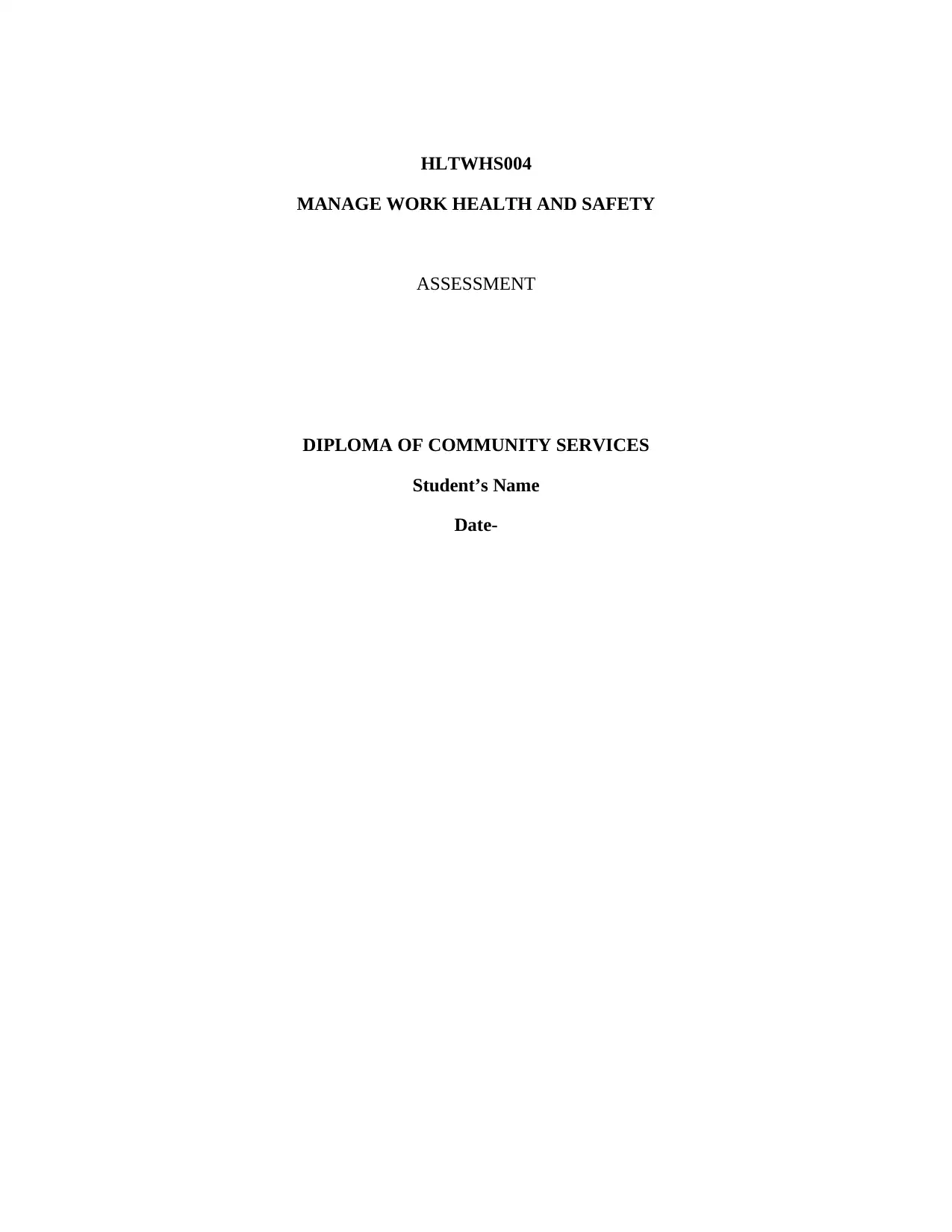
HLTWHS004
MANAGE WORK HEALTH AND SAFETY
ASSESSMENT
DIPLOMA OF COMMUNITY SERVICES
Student’s Name
Date-
MANAGE WORK HEALTH AND SAFETY
ASSESSMENT
DIPLOMA OF COMMUNITY SERVICES
Student’s Name
Date-
Paraphrase This Document
Need a fresh take? Get an instant paraphrase of this document with our AI Paraphraser
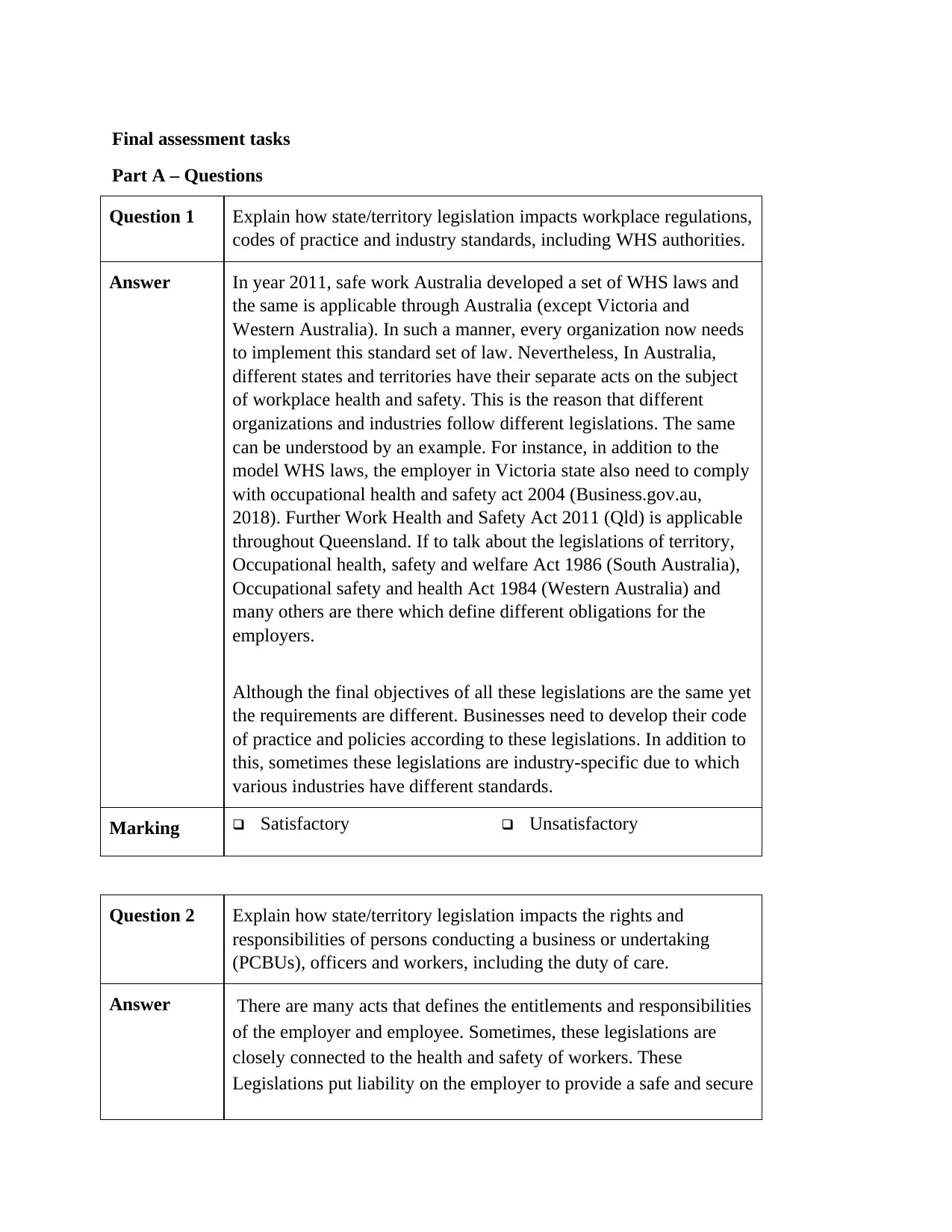
Final assessment tasks
Part A – Questions
Question 1 Explain how state/territory legislation impacts workplace regulations,
codes of practice and industry standards, including WHS authorities.
Answer In year 2011, safe work Australia developed a set of WHS laws and
the same is applicable through Australia (except Victoria and
Western Australia). In such a manner, every organization now needs
to implement this standard set of law. Nevertheless, In Australia,
different states and territories have their separate acts on the subject
of workplace health and safety. This is the reason that different
organizations and industries follow different legislations. The same
can be understood by an example. For instance, in addition to the
model WHS laws, the employer in Victoria state also need to comply
with occupational health and safety act 2004 (Business.gov.au,
2018). Further Work Health and Safety Act 2011 (Qld) is applicable
throughout Queensland. If to talk about the legislations of territory,
Occupational health, safety and welfare Act 1986 (South Australia),
Occupational safety and health Act 1984 (Western Australia) and
many others are there which define different obligations for the
employers.
Although the final objectives of all these legislations are the same yet
the requirements are different. Businesses need to develop their code
of practice and policies according to these legislations. In addition to
this, sometimes these legislations are industry-specific due to which
various industries have different standards.
Marking q Satisfactory q Unsatisfactory
Question 2 Explain how state/territory legislation impacts the rights and
responsibilities of persons conducting a business or undertaking
(PCBUs), officers and workers, including the duty of care.
Answer There are many acts that defines the entitlements and responsibilities
of the employer and employee. Sometimes, these legislations are
closely connected to the health and safety of workers. These
Legislations put liability on the employer to provide a safe and secure
Part A – Questions
Question 1 Explain how state/territory legislation impacts workplace regulations,
codes of practice and industry standards, including WHS authorities.
Answer In year 2011, safe work Australia developed a set of WHS laws and
the same is applicable through Australia (except Victoria and
Western Australia). In such a manner, every organization now needs
to implement this standard set of law. Nevertheless, In Australia,
different states and territories have their separate acts on the subject
of workplace health and safety. This is the reason that different
organizations and industries follow different legislations. The same
can be understood by an example. For instance, in addition to the
model WHS laws, the employer in Victoria state also need to comply
with occupational health and safety act 2004 (Business.gov.au,
2018). Further Work Health and Safety Act 2011 (Qld) is applicable
throughout Queensland. If to talk about the legislations of territory,
Occupational health, safety and welfare Act 1986 (South Australia),
Occupational safety and health Act 1984 (Western Australia) and
many others are there which define different obligations for the
employers.
Although the final objectives of all these legislations are the same yet
the requirements are different. Businesses need to develop their code
of practice and policies according to these legislations. In addition to
this, sometimes these legislations are industry-specific due to which
various industries have different standards.
Marking q Satisfactory q Unsatisfactory
Question 2 Explain how state/territory legislation impacts the rights and
responsibilities of persons conducting a business or undertaking
(PCBUs), officers and workers, including the duty of care.
Answer There are many acts that defines the entitlements and responsibilities
of the employer and employee. Sometimes, these legislations are
closely connected to the health and safety of workers. These
Legislations put liability on the employer to provide a safe and secure
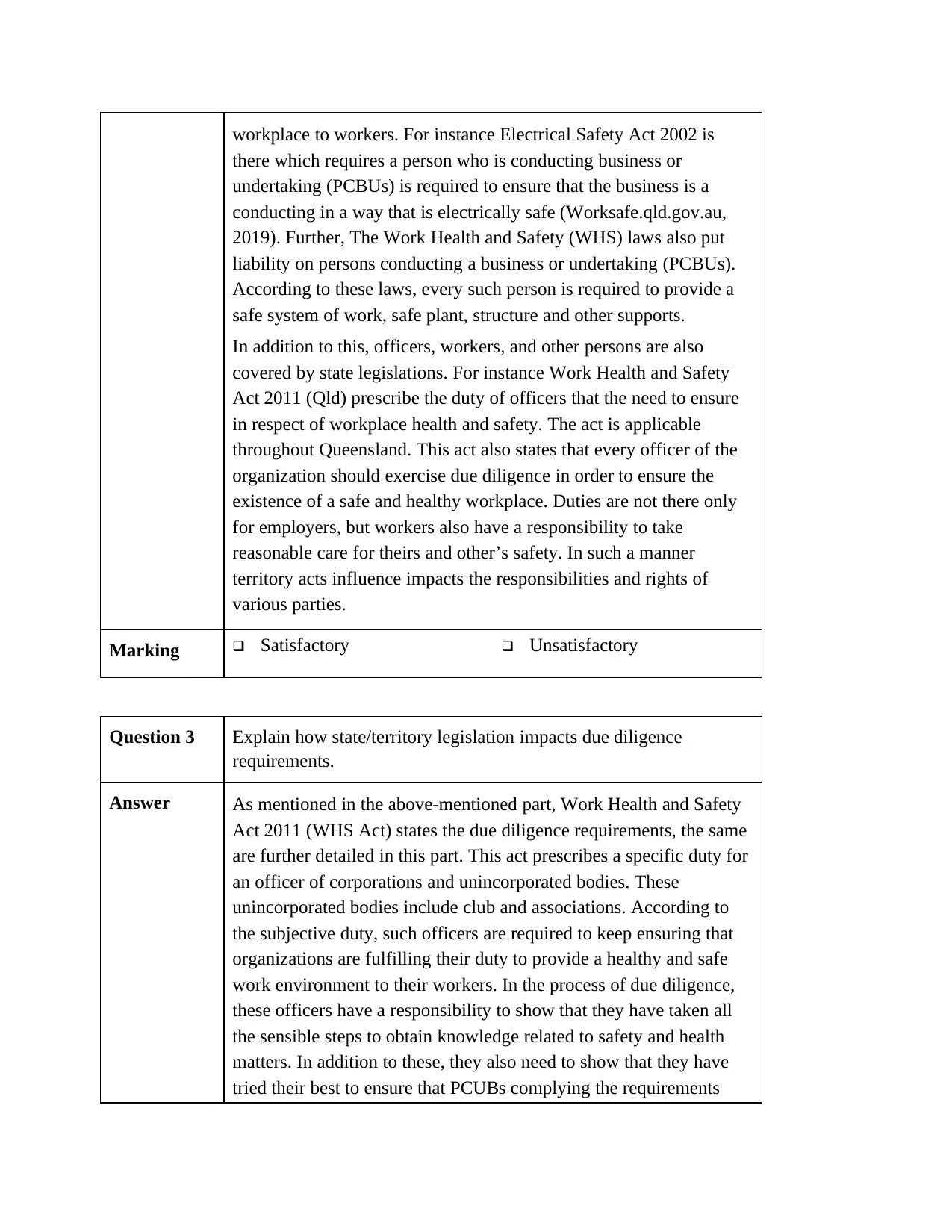
workplace to workers. For instance Electrical Safety Act 2002 is
there which requires a person who is conducting business or
undertaking (PCBUs) is required to ensure that the business is a
conducting in a way that is electrically safe (Worksafe.qld.gov.au,
2019). Further, The Work Health and Safety (WHS) laws also put
liability on persons conducting a business or undertaking (PCBUs).
According to these laws, every such person is required to provide a
safe system of work, safe plant, structure and other supports.
In addition to this, officers, workers, and other persons are also
covered by state legislations. For instance Work Health and Safety
Act 2011 (Qld) prescribe the duty of officers that the need to ensure
in respect of workplace health and safety. The act is applicable
throughout Queensland. This act also states that every officer of the
organization should exercise due diligence in order to ensure the
existence of a safe and healthy workplace. Duties are not there only
for employers, but workers also have a responsibility to take
reasonable care for theirs and other’s safety. In such a manner
territory acts influence impacts the responsibilities and rights of
various parties.
Marking q Satisfactory q Unsatisfactory
Question 3 Explain how state/territory legislation impacts due diligence
requirements.
Answer As mentioned in the above-mentioned part, Work Health and Safety
Act 2011 (WHS Act) states the due diligence requirements, the same
are further detailed in this part. This act prescribes a specific duty for
an officer of corporations and unincorporated bodies. These
unincorporated bodies include club and associations. According to
the subjective duty, such officers are required to keep ensuring that
organizations are fulfilling their duty to provide a healthy and safe
work environment to their workers. In the process of due diligence,
these officers have a responsibility to show that they have taken all
the sensible steps to obtain knowledge related to safety and health
matters. In addition to these, they also need to show that they have
tried their best to ensure that PCUBs complying the requirements
there which requires a person who is conducting business or
undertaking (PCBUs) is required to ensure that the business is a
conducting in a way that is electrically safe (Worksafe.qld.gov.au,
2019). Further, The Work Health and Safety (WHS) laws also put
liability on persons conducting a business or undertaking (PCBUs).
According to these laws, every such person is required to provide a
safe system of work, safe plant, structure and other supports.
In addition to this, officers, workers, and other persons are also
covered by state legislations. For instance Work Health and Safety
Act 2011 (Qld) prescribe the duty of officers that the need to ensure
in respect of workplace health and safety. The act is applicable
throughout Queensland. This act also states that every officer of the
organization should exercise due diligence in order to ensure the
existence of a safe and healthy workplace. Duties are not there only
for employers, but workers also have a responsibility to take
reasonable care for theirs and other’s safety. In such a manner
territory acts influence impacts the responsibilities and rights of
various parties.
Marking q Satisfactory q Unsatisfactory
Question 3 Explain how state/territory legislation impacts due diligence
requirements.
Answer As mentioned in the above-mentioned part, Work Health and Safety
Act 2011 (WHS Act) states the due diligence requirements, the same
are further detailed in this part. This act prescribes a specific duty for
an officer of corporations and unincorporated bodies. These
unincorporated bodies include club and associations. According to
the subjective duty, such officers are required to keep ensuring that
organizations are fulfilling their duty to provide a healthy and safe
work environment to their workers. In the process of due diligence,
these officers have a responsibility to show that they have taken all
the sensible steps to obtain knowledge related to safety and health
matters. In addition to these, they also need to show that they have
tried their best to ensure that PCUBs complying the requirements
⊘ This is a preview!⊘
Do you want full access?
Subscribe today to unlock all pages.

Trusted by 1+ million students worldwide
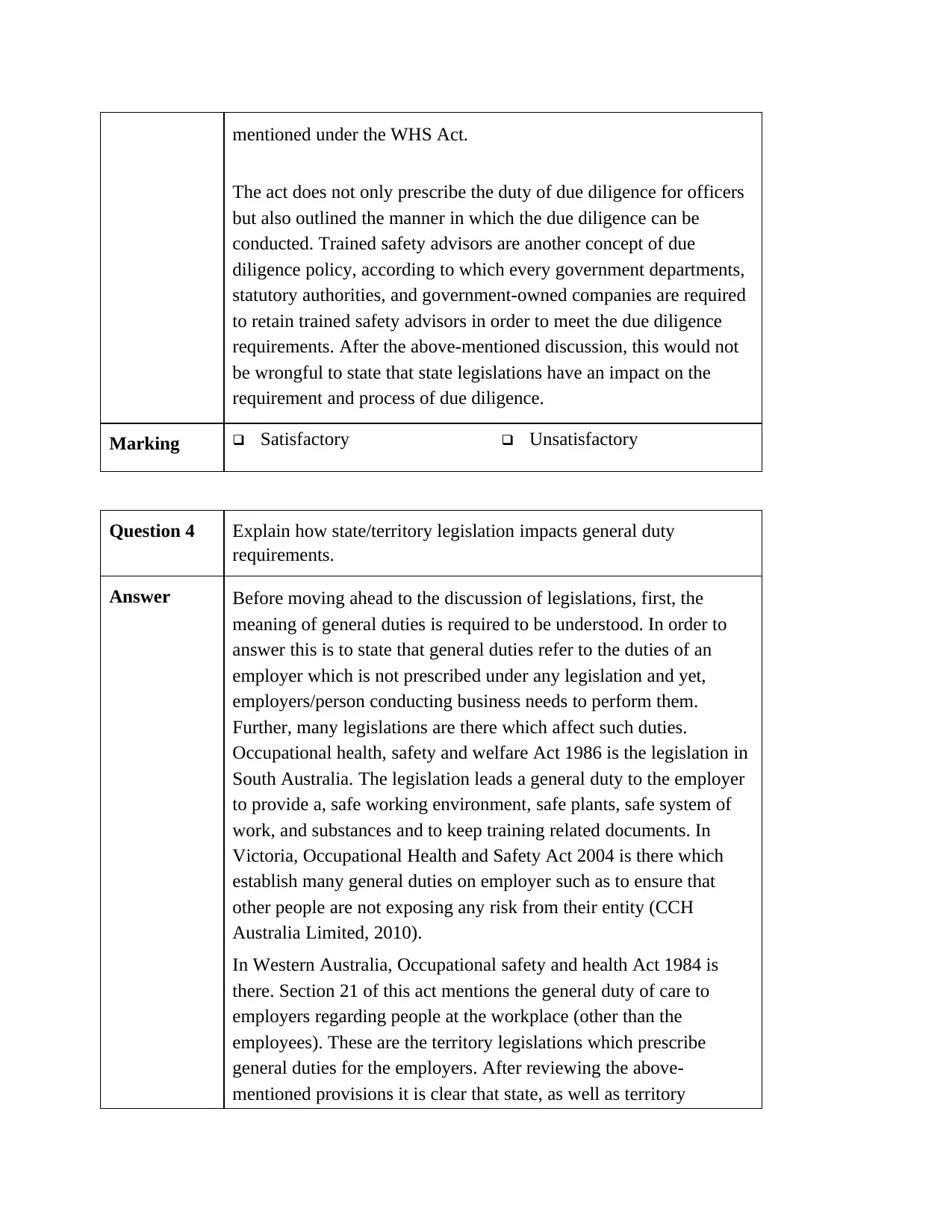
mentioned under the WHS Act.
The act does not only prescribe the duty of due diligence for officers
but also outlined the manner in which the due diligence can be
conducted. Trained safety advisors are another concept of due
diligence policy, according to which every government departments,
statutory authorities, and government-owned companies are required
to retain trained safety advisors in order to meet the due diligence
requirements. After the above-mentioned discussion, this would not
be wrongful to state that state legislations have an impact on the
requirement and process of due diligence.
Marking q Satisfactory q Unsatisfactory
Question 4 Explain how state/territory legislation impacts general duty
requirements.
Answer Before moving ahead to the discussion of legislations, first, the
meaning of general duties is required to be understood. In order to
answer this is to state that general duties refer to the duties of an
employer which is not prescribed under any legislation and yet,
employers/person conducting business needs to perform them.
Further, many legislations are there which affect such duties.
Occupational health, safety and welfare Act 1986 is the legislation in
South Australia. The legislation leads a general duty to the employer
to provide a, safe working environment, safe plants, safe system of
work, and substances and to keep training related documents. In
Victoria, Occupational Health and Safety Act 2004 is there which
establish many general duties on employer such as to ensure that
other people are not exposing any risk from their entity (CCH
Australia Limited, 2010).
In Western Australia, Occupational safety and health Act 1984 is
there. Section 21 of this act mentions the general duty of care to
employers regarding people at the workplace (other than the
employees). These are the territory legislations which prescribe
general duties for the employers. After reviewing the above-
mentioned provisions it is clear that state, as well as territory
The act does not only prescribe the duty of due diligence for officers
but also outlined the manner in which the due diligence can be
conducted. Trained safety advisors are another concept of due
diligence policy, according to which every government departments,
statutory authorities, and government-owned companies are required
to retain trained safety advisors in order to meet the due diligence
requirements. After the above-mentioned discussion, this would not
be wrongful to state that state legislations have an impact on the
requirement and process of due diligence.
Marking q Satisfactory q Unsatisfactory
Question 4 Explain how state/territory legislation impacts general duty
requirements.
Answer Before moving ahead to the discussion of legislations, first, the
meaning of general duties is required to be understood. In order to
answer this is to state that general duties refer to the duties of an
employer which is not prescribed under any legislation and yet,
employers/person conducting business needs to perform them.
Further, many legislations are there which affect such duties.
Occupational health, safety and welfare Act 1986 is the legislation in
South Australia. The legislation leads a general duty to the employer
to provide a, safe working environment, safe plants, safe system of
work, and substances and to keep training related documents. In
Victoria, Occupational Health and Safety Act 2004 is there which
establish many general duties on employer such as to ensure that
other people are not exposing any risk from their entity (CCH
Australia Limited, 2010).
In Western Australia, Occupational safety and health Act 1984 is
there. Section 21 of this act mentions the general duty of care to
employers regarding people at the workplace (other than the
employees). These are the territory legislations which prescribe
general duties for the employers. After reviewing the above-
mentioned provisions it is clear that state, as well as territory
Paraphrase This Document
Need a fresh take? Get an instant paraphrase of this document with our AI Paraphraser
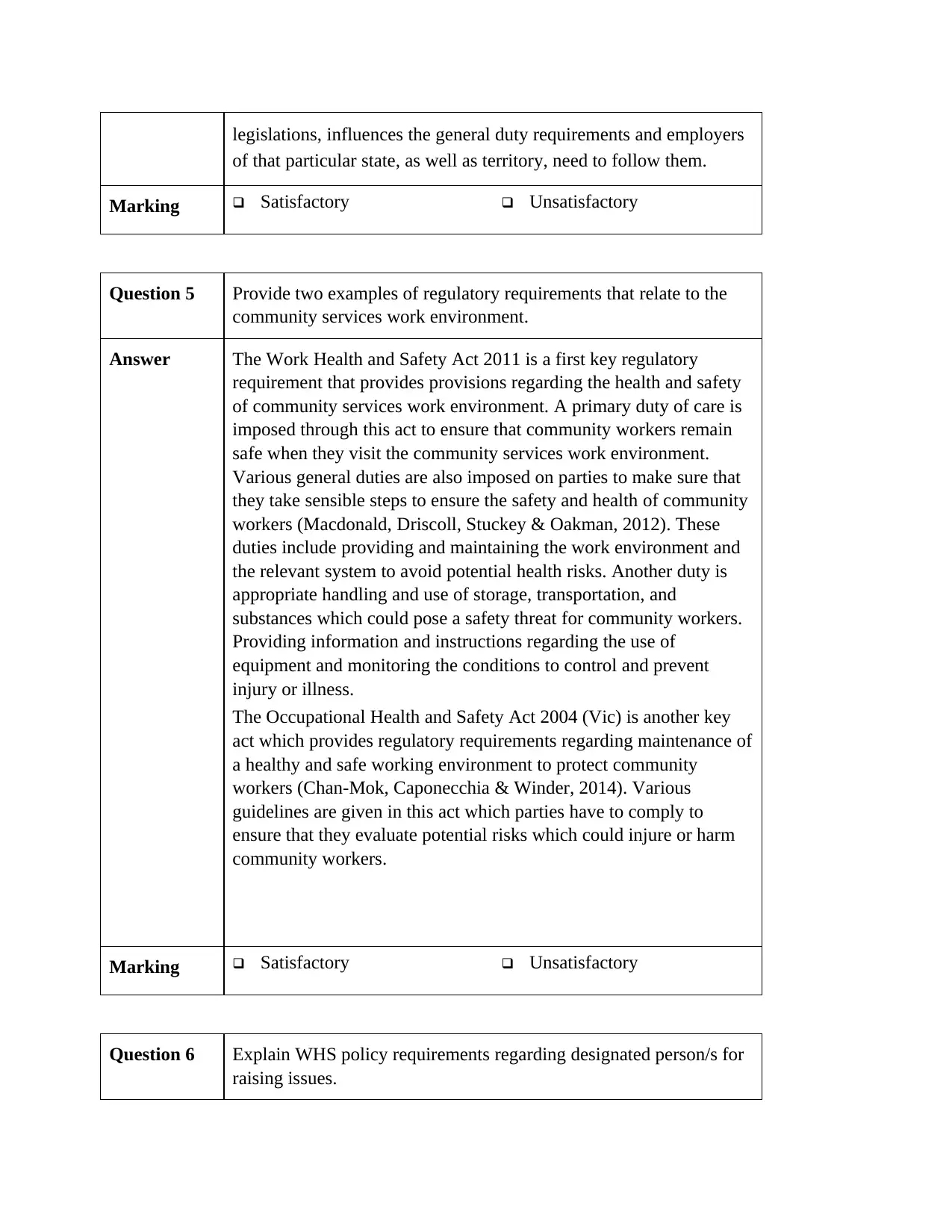
legislations, influences the general duty requirements and employers
of that particular state, as well as territory, need to follow them.
Marking q Satisfactory q Unsatisfactory
Question 5 Provide two examples of regulatory requirements that relate to the
community services work environment.
Answer The Work Health and Safety Act 2011 is a first key regulatory
requirement that provides provisions regarding the health and safety
of community services work environment. A primary duty of care is
imposed through this act to ensure that community workers remain
safe when they visit the community services work environment.
Various general duties are also imposed on parties to make sure that
they take sensible steps to ensure the safety and health of community
workers (Macdonald, Driscoll, Stuckey & Oakman, 2012). These
duties include providing and maintaining the work environment and
the relevant system to avoid potential health risks. Another duty is
appropriate handling and use of storage, transportation, and
substances which could pose a safety threat for community workers.
Providing information and instructions regarding the use of
equipment and monitoring the conditions to control and prevent
injury or illness.
The Occupational Health and Safety Act 2004 (Vic) is another key
act which provides regulatory requirements regarding maintenance of
a healthy and safe working environment to protect community
workers (Chan-Mok, Caponecchia & Winder, 2014). Various
guidelines are given in this act which parties have to comply to
ensure that they evaluate potential risks which could injure or harm
community workers.
Marking q Satisfactory q Unsatisfactory
Question 6 Explain WHS policy requirements regarding designated person/s for
raising issues.
of that particular state, as well as territory, need to follow them.
Marking q Satisfactory q Unsatisfactory
Question 5 Provide two examples of regulatory requirements that relate to the
community services work environment.
Answer The Work Health and Safety Act 2011 is a first key regulatory
requirement that provides provisions regarding the health and safety
of community services work environment. A primary duty of care is
imposed through this act to ensure that community workers remain
safe when they visit the community services work environment.
Various general duties are also imposed on parties to make sure that
they take sensible steps to ensure the safety and health of community
workers (Macdonald, Driscoll, Stuckey & Oakman, 2012). These
duties include providing and maintaining the work environment and
the relevant system to avoid potential health risks. Another duty is
appropriate handling and use of storage, transportation, and
substances which could pose a safety threat for community workers.
Providing information and instructions regarding the use of
equipment and monitoring the conditions to control and prevent
injury or illness.
The Occupational Health and Safety Act 2004 (Vic) is another key
act which provides regulatory requirements regarding maintenance of
a healthy and safe working environment to protect community
workers (Chan-Mok, Caponecchia & Winder, 2014). Various
guidelines are given in this act which parties have to comply to
ensure that they evaluate potential risks which could injure or harm
community workers.
Marking q Satisfactory q Unsatisfactory
Question 6 Explain WHS policy requirements regarding designated person/s for
raising issues.
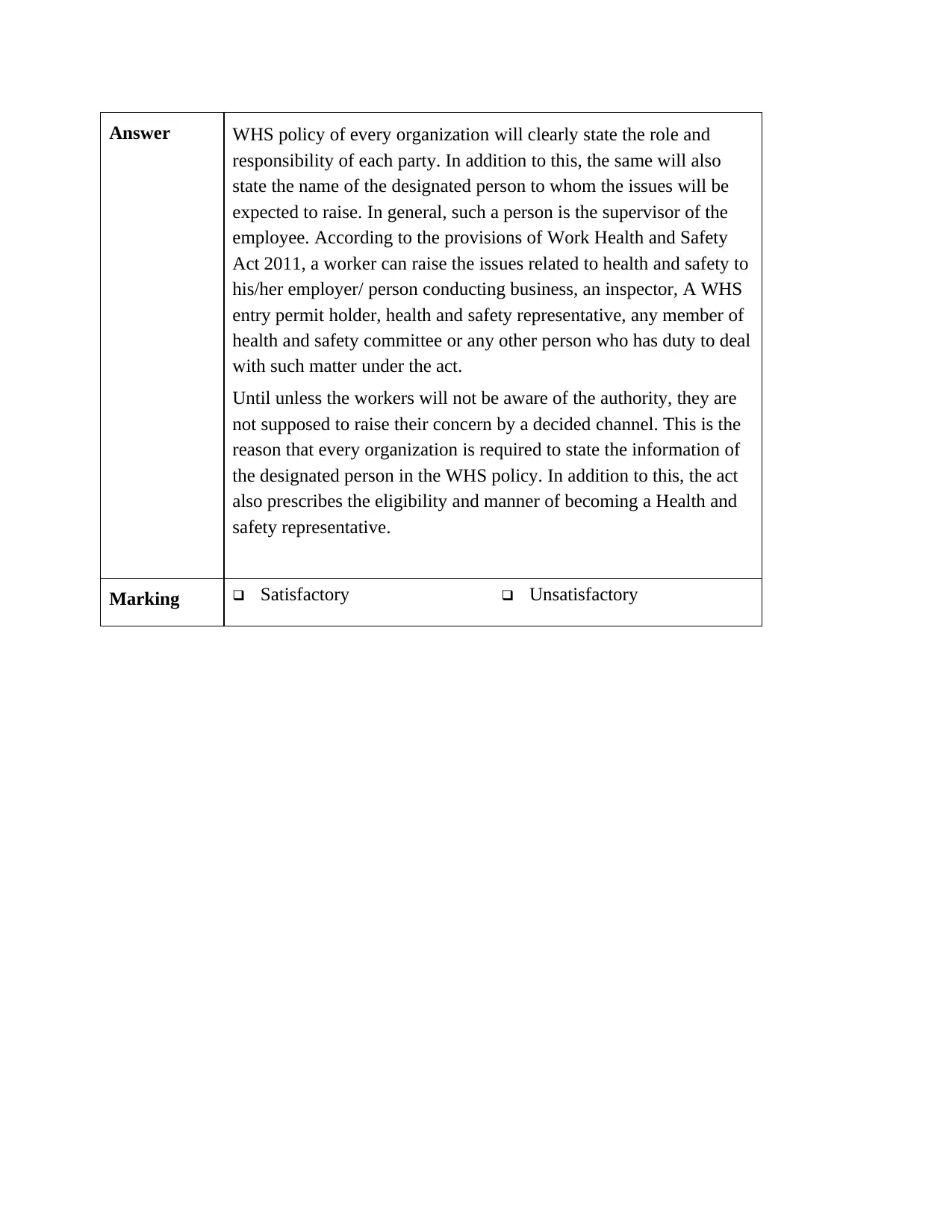
Answer WHS policy of every organization will clearly state the role and
responsibility of each party. In addition to this, the same will also
state the name of the designated person to whom the issues will be
expected to raise. In general, such a person is the supervisor of the
employee. According to the provisions of Work Health and Safety
Act 2011, a worker can raise the issues related to health and safety to
his/her employer/ person conducting business, an inspector, A WHS
entry permit holder, health and safety representative, any member of
health and safety committee or any other person who has duty to deal
with such matter under the act.
Until unless the workers will not be aware of the authority, they are
not supposed to raise their concern by a decided channel. This is the
reason that every organization is required to state the information of
the designated person in the WHS policy. In addition to this, the act
also prescribes the eligibility and manner of becoming a Health and
safety representative.
Marking q Satisfactory q Unsatisfactory
responsibility of each party. In addition to this, the same will also
state the name of the designated person to whom the issues will be
expected to raise. In general, such a person is the supervisor of the
employee. According to the provisions of Work Health and Safety
Act 2011, a worker can raise the issues related to health and safety to
his/her employer/ person conducting business, an inspector, A WHS
entry permit holder, health and safety representative, any member of
health and safety committee or any other person who has duty to deal
with such matter under the act.
Until unless the workers will not be aware of the authority, they are
not supposed to raise their concern by a decided channel. This is the
reason that every organization is required to state the information of
the designated person in the WHS policy. In addition to this, the act
also prescribes the eligibility and manner of becoming a Health and
safety representative.
Marking q Satisfactory q Unsatisfactory
⊘ This is a preview!⊘
Do you want full access?
Subscribe today to unlock all pages.

Trusted by 1+ million students worldwide
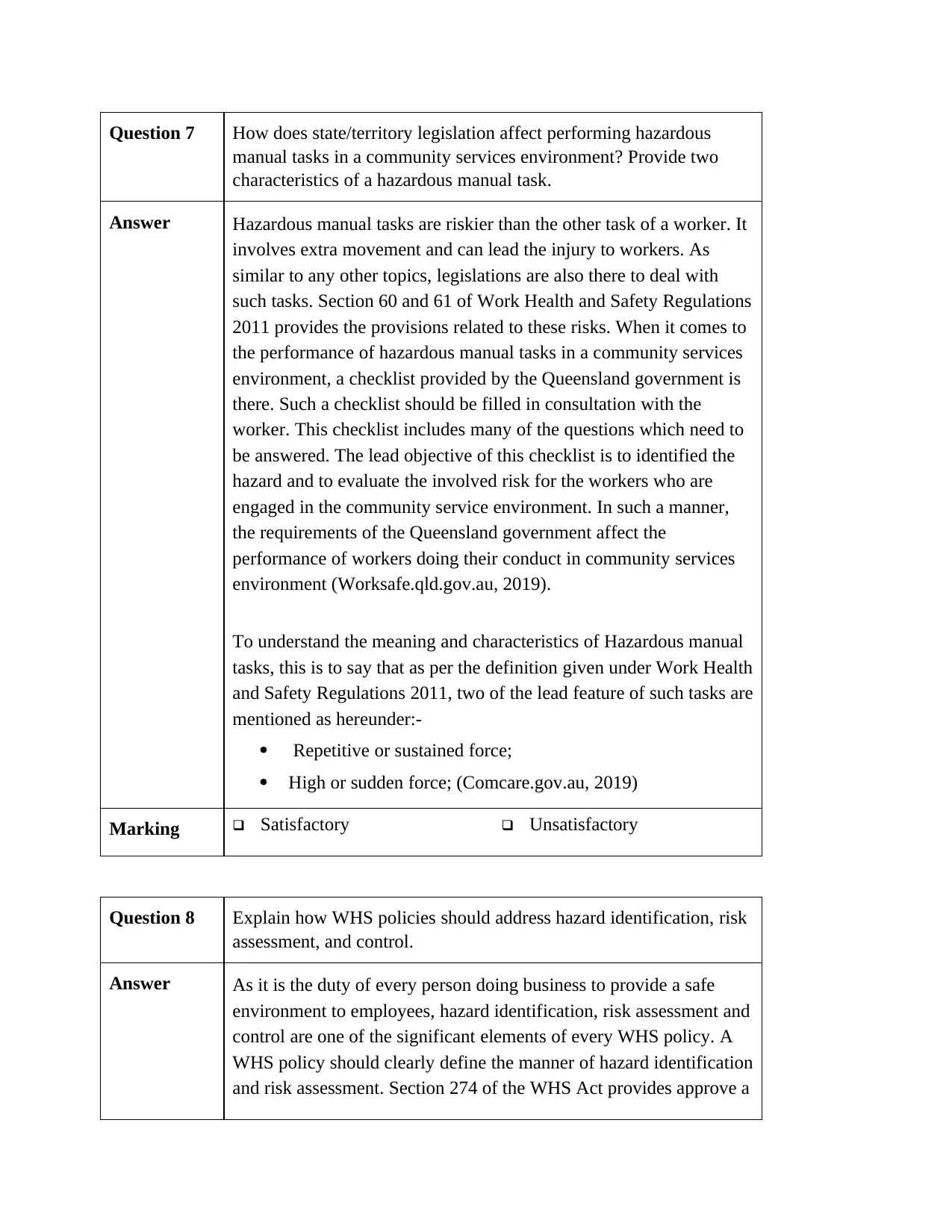
Question 7 How does state/territory legislation affect performing hazardous
manual tasks in a community services environment? Provide two
characteristics of a hazardous manual task.
Answer Hazardous manual tasks are riskier than the other task of a worker. It
involves extra movement and can lead the injury to workers. As
similar to any other topics, legislations are also there to deal with
such tasks. Section 60 and 61 of Work Health and Safety Regulations
2011 provides the provisions related to these risks. When it comes to
the performance of hazardous manual tasks in a community services
environment, a checklist provided by the Queensland government is
there. Such a checklist should be filled in consultation with the
worker. This checklist includes many of the questions which need to
be answered. The lead objective of this checklist is to identified the
hazard and to evaluate the involved risk for the workers who are
engaged in the community service environment. In such a manner,
the requirements of the Queensland government affect the
performance of workers doing their conduct in community services
environment (Worksafe.qld.gov.au, 2019).
To understand the meaning and characteristics of Hazardous manual
tasks, this is to say that as per the definition given under Work Health
and Safety Regulations 2011, two of the lead feature of such tasks are
mentioned as hereunder:-
Repetitive or sustained force;
High or sudden force; (Comcare.gov.au, 2019)
Marking q Satisfactory q Unsatisfactory
Question 8 Explain how WHS policies should address hazard identification, risk
assessment, and control.
Answer As it is the duty of every person doing business to provide a safe
environment to employees, hazard identification, risk assessment and
control are one of the significant elements of every WHS policy. A
WHS policy should clearly define the manner of hazard identification
and risk assessment. Section 274 of the WHS Act provides approve a
manual tasks in a community services environment? Provide two
characteristics of a hazardous manual task.
Answer Hazardous manual tasks are riskier than the other task of a worker. It
involves extra movement and can lead the injury to workers. As
similar to any other topics, legislations are also there to deal with
such tasks. Section 60 and 61 of Work Health and Safety Regulations
2011 provides the provisions related to these risks. When it comes to
the performance of hazardous manual tasks in a community services
environment, a checklist provided by the Queensland government is
there. Such a checklist should be filled in consultation with the
worker. This checklist includes many of the questions which need to
be answered. The lead objective of this checklist is to identified the
hazard and to evaluate the involved risk for the workers who are
engaged in the community service environment. In such a manner,
the requirements of the Queensland government affect the
performance of workers doing their conduct in community services
environment (Worksafe.qld.gov.au, 2019).
To understand the meaning and characteristics of Hazardous manual
tasks, this is to say that as per the definition given under Work Health
and Safety Regulations 2011, two of the lead feature of such tasks are
mentioned as hereunder:-
Repetitive or sustained force;
High or sudden force; (Comcare.gov.au, 2019)
Marking q Satisfactory q Unsatisfactory
Question 8 Explain how WHS policies should address hazard identification, risk
assessment, and control.
Answer As it is the duty of every person doing business to provide a safe
environment to employees, hazard identification, risk assessment and
control are one of the significant elements of every WHS policy. A
WHS policy should clearly define the manner of hazard identification
and risk assessment. Section 274 of the WHS Act provides approve a
Paraphrase This Document
Need a fresh take? Get an instant paraphrase of this document with our AI Paraphraser
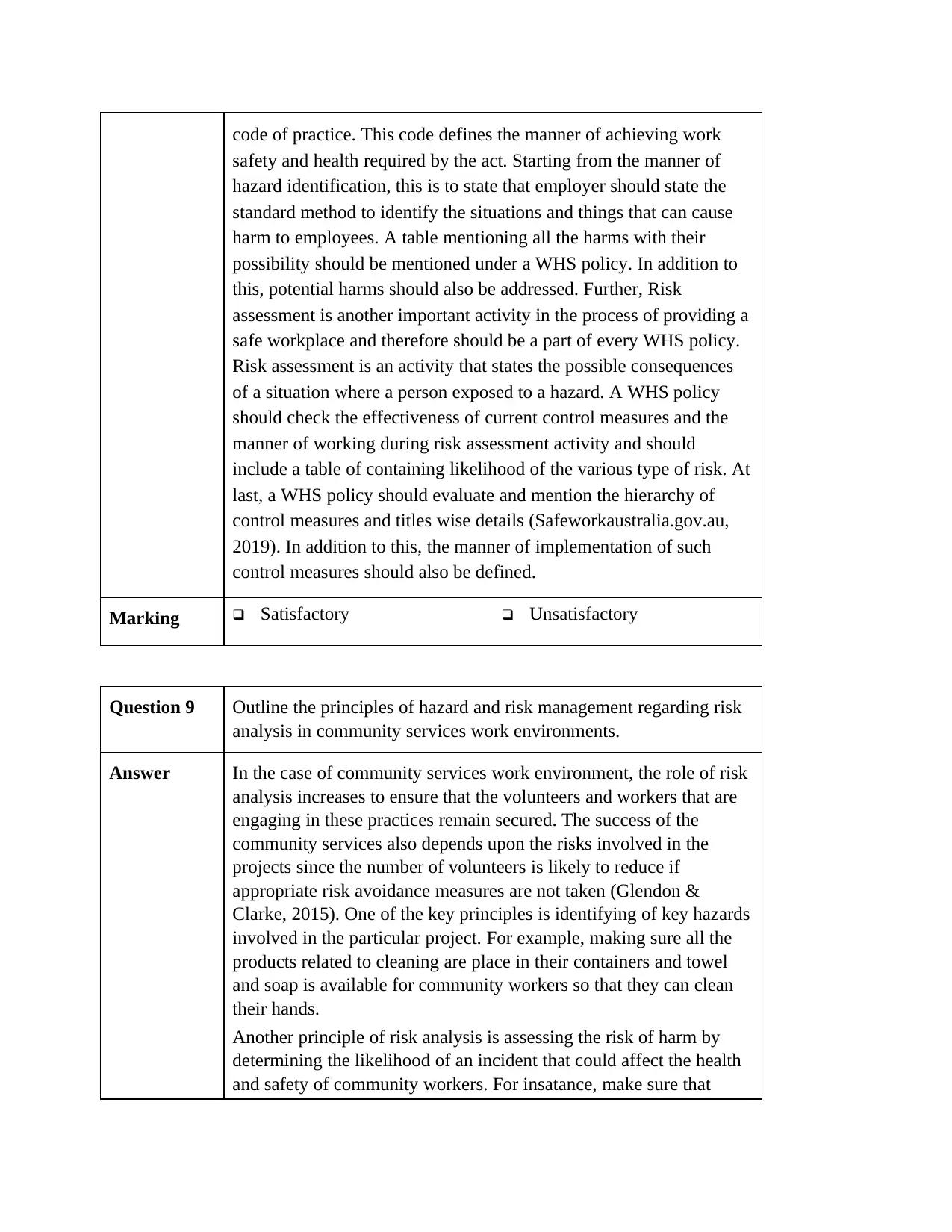
code of practice. This code defines the manner of achieving work
safety and health required by the act. Starting from the manner of
hazard identification, this is to state that employer should state the
standard method to identify the situations and things that can cause
harm to employees. A table mentioning all the harms with their
possibility should be mentioned under a WHS policy. In addition to
this, potential harms should also be addressed. Further, Risk
assessment is another important activity in the process of providing a
safe workplace and therefore should be a part of every WHS policy.
Risk assessment is an activity that states the possible consequences
of a situation where a person exposed to a hazard. A WHS policy
should check the effectiveness of current control measures and the
manner of working during risk assessment activity and should
include a table of containing likelihood of the various type of risk. At
last, a WHS policy should evaluate and mention the hierarchy of
control measures and titles wise details (Safeworkaustralia.gov.au,
2019). In addition to this, the manner of implementation of such
control measures should also be defined.
Marking q Satisfactory q Unsatisfactory
Question 9 Outline the principles of hazard and risk management regarding risk
analysis in community services work environments.
Answer In the case of community services work environment, the role of risk
analysis increases to ensure that the volunteers and workers that are
engaging in these practices remain secured. The success of the
community services also depends upon the risks involved in the
projects since the number of volunteers is likely to reduce if
appropriate risk avoidance measures are not taken (Glendon &
Clarke, 2015). One of the key principles is identifying of key hazards
involved in the particular project. For example, making sure all the
products related to cleaning are place in their containers and towel
and soap is available for community workers so that they can clean
their hands.
Another principle of risk analysis is assessing the risk of harm by
determining the likelihood of an incident that could affect the health
and safety of community workers. For insatance, make sure that
safety and health required by the act. Starting from the manner of
hazard identification, this is to state that employer should state the
standard method to identify the situations and things that can cause
harm to employees. A table mentioning all the harms with their
possibility should be mentioned under a WHS policy. In addition to
this, potential harms should also be addressed. Further, Risk
assessment is another important activity in the process of providing a
safe workplace and therefore should be a part of every WHS policy.
Risk assessment is an activity that states the possible consequences
of a situation where a person exposed to a hazard. A WHS policy
should check the effectiveness of current control measures and the
manner of working during risk assessment activity and should
include a table of containing likelihood of the various type of risk. At
last, a WHS policy should evaluate and mention the hierarchy of
control measures and titles wise details (Safeworkaustralia.gov.au,
2019). In addition to this, the manner of implementation of such
control measures should also be defined.
Marking q Satisfactory q Unsatisfactory
Question 9 Outline the principles of hazard and risk management regarding risk
analysis in community services work environments.
Answer In the case of community services work environment, the role of risk
analysis increases to ensure that the volunteers and workers that are
engaging in these practices remain secured. The success of the
community services also depends upon the risks involved in the
projects since the number of volunteers is likely to reduce if
appropriate risk avoidance measures are not taken (Glendon &
Clarke, 2015). One of the key principles is identifying of key hazards
involved in the particular project. For example, making sure all the
products related to cleaning are place in their containers and towel
and soap is available for community workers so that they can clean
their hands.
Another principle of risk analysis is assessing the risk of harm by
determining the likelihood of an incident that could affect the health
and safety of community workers. For insatance, make sure that
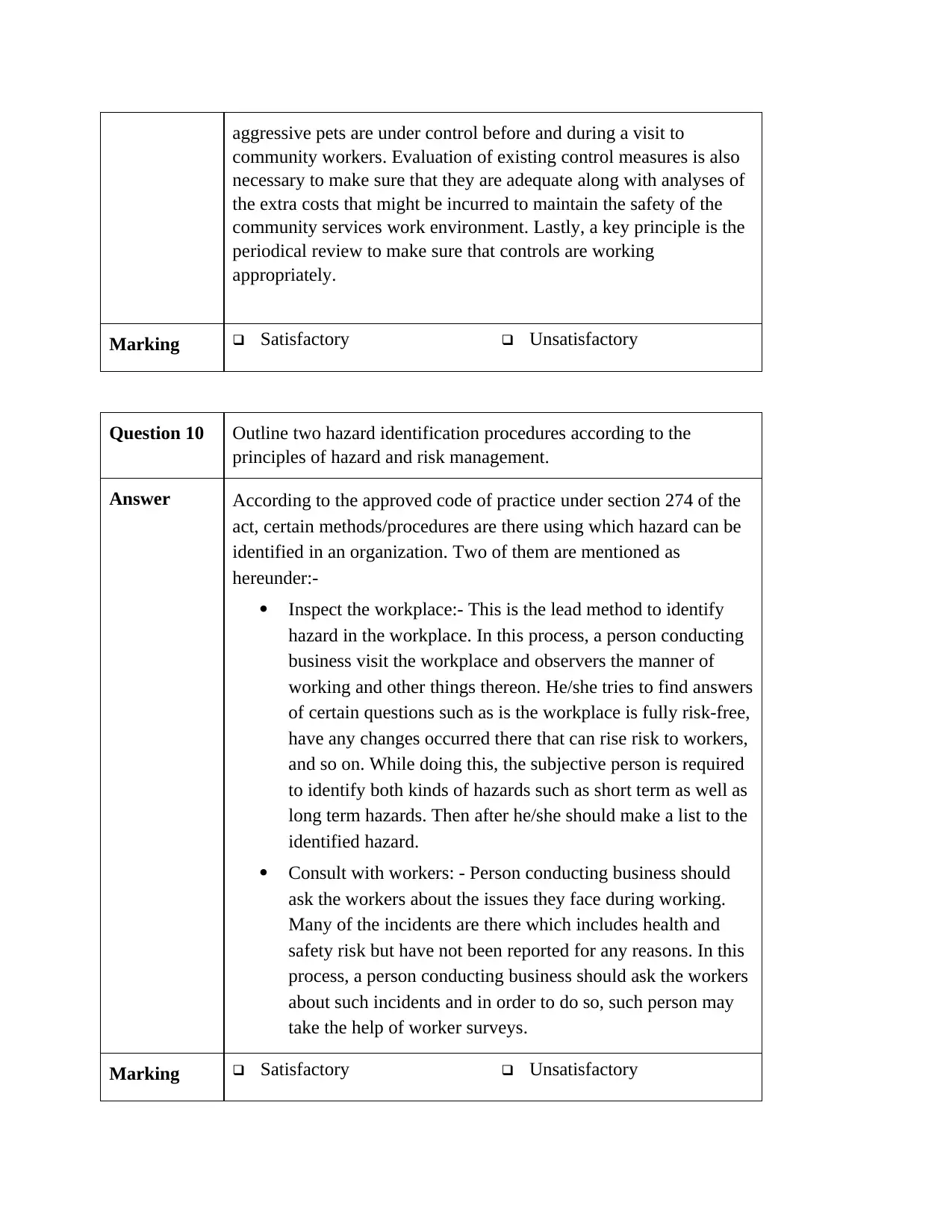
aggressive pets are under control before and during a visit to
community workers. Evaluation of existing control measures is also
necessary to make sure that they are adequate along with analyses of
the extra costs that might be incurred to maintain the safety of the
community services work environment. Lastly, a key principle is the
periodical review to make sure that controls are working
appropriately.
Marking q Satisfactory q Unsatisfactory
Question 10 Outline two hazard identification procedures according to the
principles of hazard and risk management.
Answer According to the approved code of practice under section 274 of the
act, certain methods/procedures are there using which hazard can be
identified in an organization. Two of them are mentioned as
hereunder:-
Inspect the workplace:- This is the lead method to identify
hazard in the workplace. In this process, a person conducting
business visit the workplace and observers the manner of
working and other things thereon. He/she tries to find answers
of certain questions such as is the workplace is fully risk-free,
have any changes occurred there that can rise risk to workers,
and so on. While doing this, the subjective person is required
to identify both kinds of hazards such as short term as well as
long term hazards. Then after he/she should make a list to the
identified hazard.
Consult with workers: - Person conducting business should
ask the workers about the issues they face during working.
Many of the incidents are there which includes health and
safety risk but have not been reported for any reasons. In this
process, a person conducting business should ask the workers
about such incidents and in order to do so, such person may
take the help of worker surveys.
Marking q Satisfactory q Unsatisfactory
community workers. Evaluation of existing control measures is also
necessary to make sure that they are adequate along with analyses of
the extra costs that might be incurred to maintain the safety of the
community services work environment. Lastly, a key principle is the
periodical review to make sure that controls are working
appropriately.
Marking q Satisfactory q Unsatisfactory
Question 10 Outline two hazard identification procedures according to the
principles of hazard and risk management.
Answer According to the approved code of practice under section 274 of the
act, certain methods/procedures are there using which hazard can be
identified in an organization. Two of them are mentioned as
hereunder:-
Inspect the workplace:- This is the lead method to identify
hazard in the workplace. In this process, a person conducting
business visit the workplace and observers the manner of
working and other things thereon. He/she tries to find answers
of certain questions such as is the workplace is fully risk-free,
have any changes occurred there that can rise risk to workers,
and so on. While doing this, the subjective person is required
to identify both kinds of hazards such as short term as well as
long term hazards. Then after he/she should make a list to the
identified hazard.
Consult with workers: - Person conducting business should
ask the workers about the issues they face during working.
Many of the incidents are there which includes health and
safety risk but have not been reported for any reasons. In this
process, a person conducting business should ask the workers
about such incidents and in order to do so, such person may
take the help of worker surveys.
Marking q Satisfactory q Unsatisfactory
⊘ This is a preview!⊘
Do you want full access?
Subscribe today to unlock all pages.

Trusted by 1+ million students worldwide
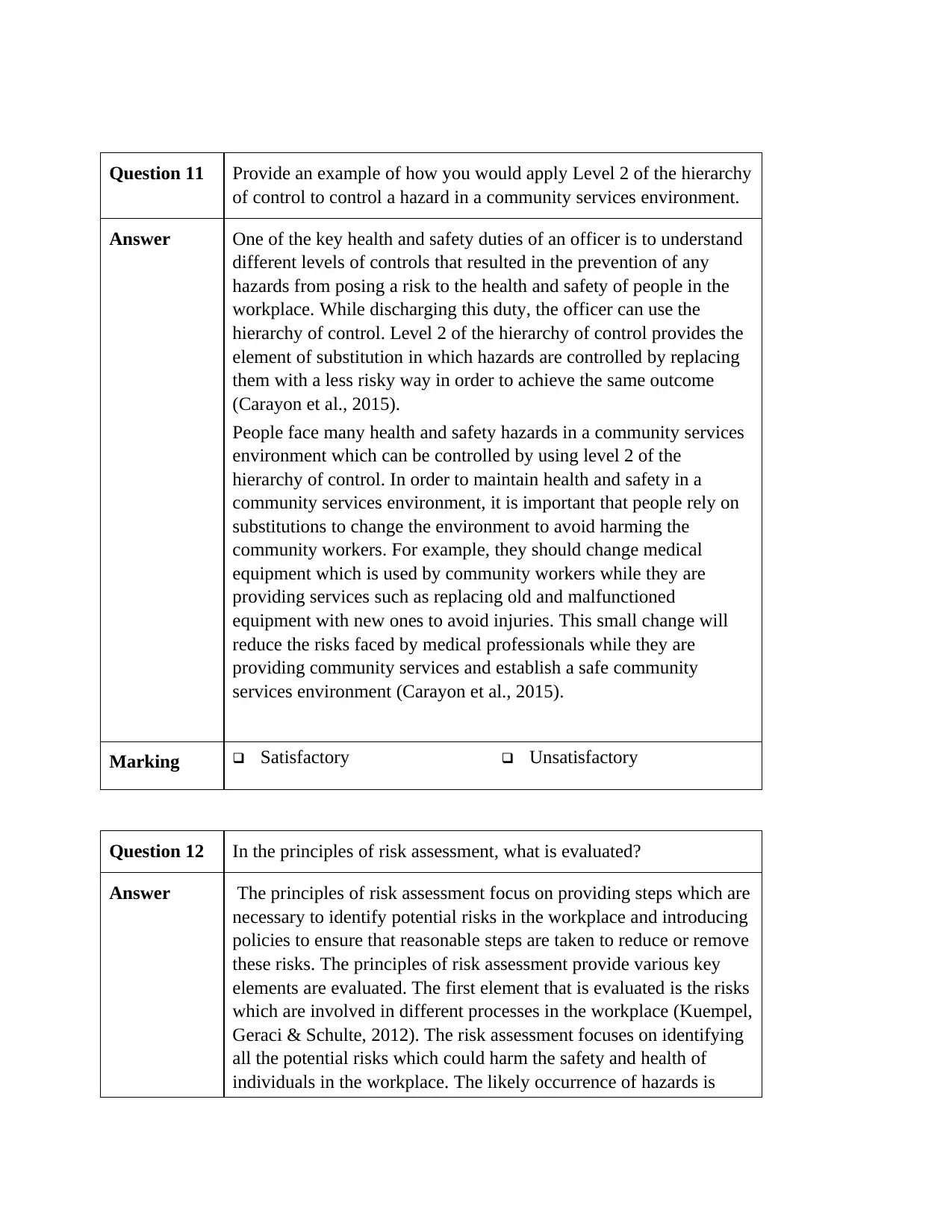
Question 11 Provide an example of how you would apply Level 2 of the hierarchy
of control to control a hazard in a community services environment.
Answer One of the key health and safety duties of an officer is to understand
different levels of controls that resulted in the prevention of any
hazards from posing a risk to the health and safety of people in the
workplace. While discharging this duty, the officer can use the
hierarchy of control. Level 2 of the hierarchy of control provides the
element of substitution in which hazards are controlled by replacing
them with a less risky way in order to achieve the same outcome
(Carayon et al., 2015).
People face many health and safety hazards in a community services
environment which can be controlled by using level 2 of the
hierarchy of control. In order to maintain health and safety in a
community services environment, it is important that people rely on
substitutions to change the environment to avoid harming the
community workers. For example, they should change medical
equipment which is used by community workers while they are
providing services such as replacing old and malfunctioned
equipment with new ones to avoid injuries. This small change will
reduce the risks faced by medical professionals while they are
providing community services and establish a safe community
services environment (Carayon et al., 2015).
Marking q Satisfactory q Unsatisfactory
Question 12 In the principles of risk assessment, what is evaluated?
Answer The principles of risk assessment focus on providing steps which are
necessary to identify potential risks in the workplace and introducing
policies to ensure that reasonable steps are taken to reduce or remove
these risks. The principles of risk assessment provide various key
elements are evaluated. The first element that is evaluated is the risks
which are involved in different processes in the workplace (Kuempel,
Geraci & Schulte, 2012). The risk assessment focuses on identifying
all the potential risks which could harm the safety and health of
individuals in the workplace. The likely occurrence of hazards is
of control to control a hazard in a community services environment.
Answer One of the key health and safety duties of an officer is to understand
different levels of controls that resulted in the prevention of any
hazards from posing a risk to the health and safety of people in the
workplace. While discharging this duty, the officer can use the
hierarchy of control. Level 2 of the hierarchy of control provides the
element of substitution in which hazards are controlled by replacing
them with a less risky way in order to achieve the same outcome
(Carayon et al., 2015).
People face many health and safety hazards in a community services
environment which can be controlled by using level 2 of the
hierarchy of control. In order to maintain health and safety in a
community services environment, it is important that people rely on
substitutions to change the environment to avoid harming the
community workers. For example, they should change medical
equipment which is used by community workers while they are
providing services such as replacing old and malfunctioned
equipment with new ones to avoid injuries. This small change will
reduce the risks faced by medical professionals while they are
providing community services and establish a safe community
services environment (Carayon et al., 2015).
Marking q Satisfactory q Unsatisfactory
Question 12 In the principles of risk assessment, what is evaluated?
Answer The principles of risk assessment focus on providing steps which are
necessary to identify potential risks in the workplace and introducing
policies to ensure that reasonable steps are taken to reduce or remove
these risks. The principles of risk assessment provide various key
elements are evaluated. The first element that is evaluated is the risks
which are involved in different processes in the workplace (Kuempel,
Geraci & Schulte, 2012). The risk assessment focuses on identifying
all the potential risks which could harm the safety and health of
individuals in the workplace. The likely occurrence of hazards is
Paraphrase This Document
Need a fresh take? Get an instant paraphrase of this document with our AI Paraphraser
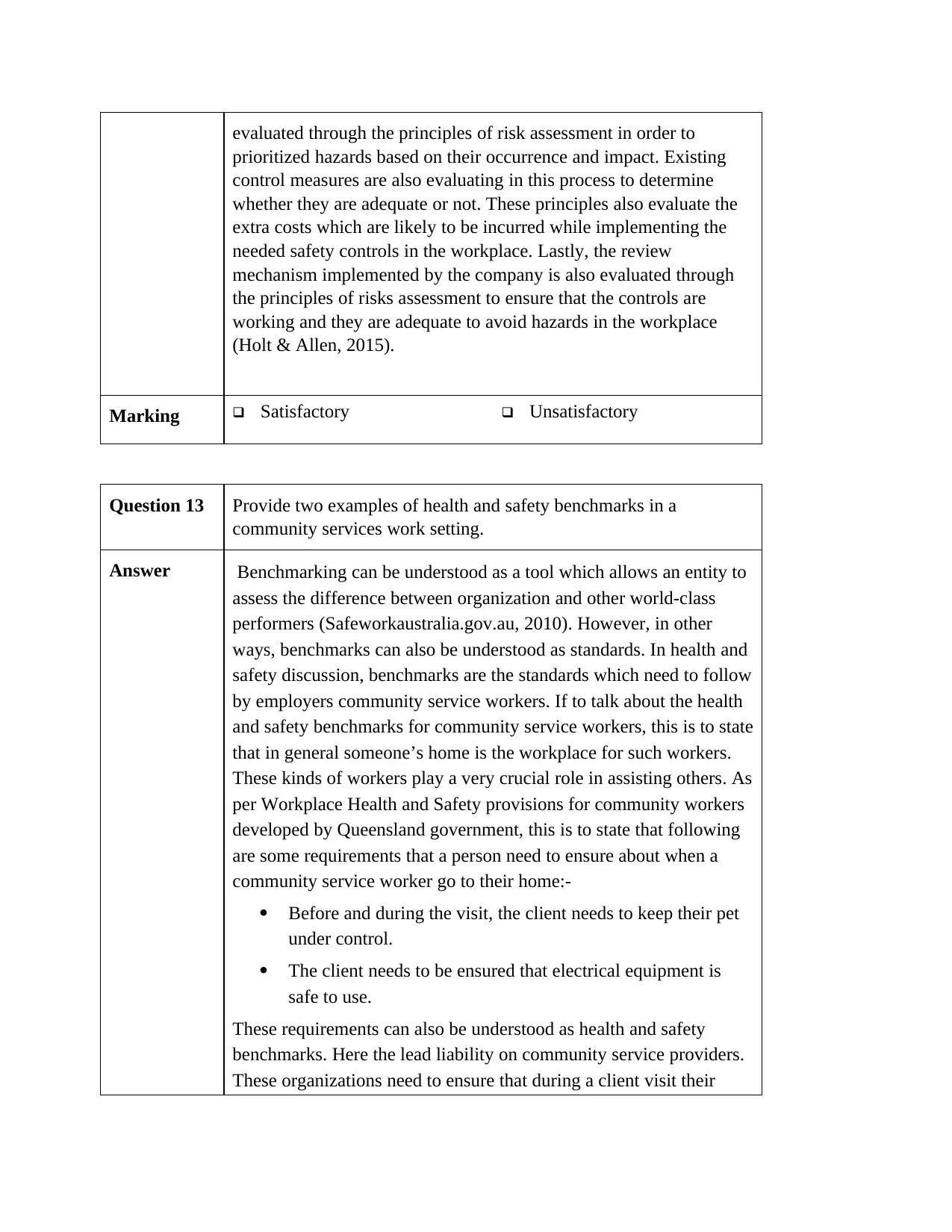
evaluated through the principles of risk assessment in order to
prioritized hazards based on their occurrence and impact. Existing
control measures are also evaluating in this process to determine
whether they are adequate or not. These principles also evaluate the
extra costs which are likely to be incurred while implementing the
needed safety controls in the workplace. Lastly, the review
mechanism implemented by the company is also evaluated through
the principles of risks assessment to ensure that the controls are
working and they are adequate to avoid hazards in the workplace
(Holt & Allen, 2015).
Marking q Satisfactory q Unsatisfactory
Question 13 Provide two examples of health and safety benchmarks in a
community services work setting.
Answer Benchmarking can be understood as a tool which allows an entity to
assess the difference between organization and other world-class
performers (Safeworkaustralia.gov.au, 2010). However, in other
ways, benchmarks can also be understood as standards. In health and
safety discussion, benchmarks are the standards which need to follow
by employers community service workers. If to talk about the health
and safety benchmarks for community service workers, this is to state
that in general someone’s home is the workplace for such workers.
These kinds of workers play a very crucial role in assisting others. As
per Workplace Health and Safety provisions for community workers
developed by Queensland government, this is to state that following
are some requirements that a person need to ensure about when a
community service worker go to their home:-
Before and during the visit, the client needs to keep their pet
under control.
The client needs to be ensured that electrical equipment is
safe to use.
These requirements can also be understood as health and safety
benchmarks. Here the lead liability on community service providers.
These organizations need to ensure that during a client visit their
prioritized hazards based on their occurrence and impact. Existing
control measures are also evaluating in this process to determine
whether they are adequate or not. These principles also evaluate the
extra costs which are likely to be incurred while implementing the
needed safety controls in the workplace. Lastly, the review
mechanism implemented by the company is also evaluated through
the principles of risks assessment to ensure that the controls are
working and they are adequate to avoid hazards in the workplace
(Holt & Allen, 2015).
Marking q Satisfactory q Unsatisfactory
Question 13 Provide two examples of health and safety benchmarks in a
community services work setting.
Answer Benchmarking can be understood as a tool which allows an entity to
assess the difference between organization and other world-class
performers (Safeworkaustralia.gov.au, 2010). However, in other
ways, benchmarks can also be understood as standards. In health and
safety discussion, benchmarks are the standards which need to follow
by employers community service workers. If to talk about the health
and safety benchmarks for community service workers, this is to state
that in general someone’s home is the workplace for such workers.
These kinds of workers play a very crucial role in assisting others. As
per Workplace Health and Safety provisions for community workers
developed by Queensland government, this is to state that following
are some requirements that a person need to ensure about when a
community service worker go to their home:-
Before and during the visit, the client needs to keep their pet
under control.
The client needs to be ensured that electrical equipment is
safe to use.
These requirements can also be understood as health and safety
benchmarks. Here the lead liability on community service providers.
These organizations need to ensure that during a client visit their
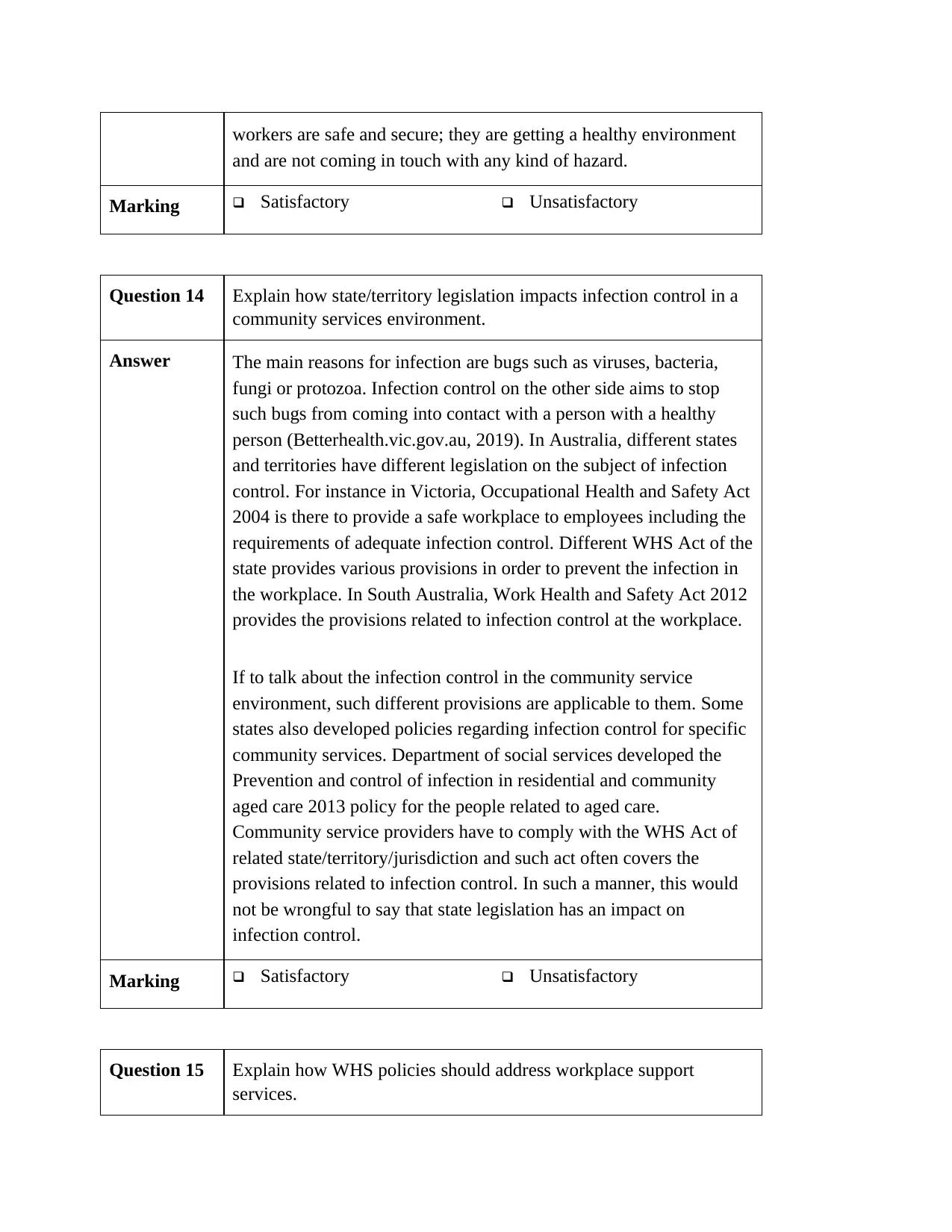
workers are safe and secure; they are getting a healthy environment
and are not coming in touch with any kind of hazard.
Marking q Satisfactory q Unsatisfactory
Question 14 Explain how state/territory legislation impacts infection control in a
community services environment.
Answer The main reasons for infection are bugs such as viruses, bacteria,
fungi or protozoa. Infection control on the other side aims to stop
such bugs from coming into contact with a person with a healthy
person (Betterhealth.vic.gov.au, 2019). In Australia, different states
and territories have different legislation on the subject of infection
control. For instance in Victoria, Occupational Health and Safety Act
2004 is there to provide a safe workplace to employees including the
requirements of adequate infection control. Different WHS Act of the
state provides various provisions in order to prevent the infection in
the workplace. In South Australia, Work Health and Safety Act 2012
provides the provisions related to infection control at the workplace.
If to talk about the infection control in the community service
environment, such different provisions are applicable to them. Some
states also developed policies regarding infection control for specific
community services. Department of social services developed the
Prevention and control of infection in residential and community
aged care 2013 policy for the people related to aged care.
Community service providers have to comply with the WHS Act of
related state/territory/jurisdiction and such act often covers the
provisions related to infection control. In such a manner, this would
not be wrongful to say that state legislation has an impact on
infection control.
Marking q Satisfactory q Unsatisfactory
Question 15 Explain how WHS policies should address workplace support
services.
and are not coming in touch with any kind of hazard.
Marking q Satisfactory q Unsatisfactory
Question 14 Explain how state/territory legislation impacts infection control in a
community services environment.
Answer The main reasons for infection are bugs such as viruses, bacteria,
fungi or protozoa. Infection control on the other side aims to stop
such bugs from coming into contact with a person with a healthy
person (Betterhealth.vic.gov.au, 2019). In Australia, different states
and territories have different legislation on the subject of infection
control. For instance in Victoria, Occupational Health and Safety Act
2004 is there to provide a safe workplace to employees including the
requirements of adequate infection control. Different WHS Act of the
state provides various provisions in order to prevent the infection in
the workplace. In South Australia, Work Health and Safety Act 2012
provides the provisions related to infection control at the workplace.
If to talk about the infection control in the community service
environment, such different provisions are applicable to them. Some
states also developed policies regarding infection control for specific
community services. Department of social services developed the
Prevention and control of infection in residential and community
aged care 2013 policy for the people related to aged care.
Community service providers have to comply with the WHS Act of
related state/territory/jurisdiction and such act often covers the
provisions related to infection control. In such a manner, this would
not be wrongful to say that state legislation has an impact on
infection control.
Marking q Satisfactory q Unsatisfactory
Question 15 Explain how WHS policies should address workplace support
services.
⊘ This is a preview!⊘
Do you want full access?
Subscribe today to unlock all pages.

Trusted by 1+ million students worldwide
1 out of 24
Related Documents
Your All-in-One AI-Powered Toolkit for Academic Success.
+13062052269
info@desklib.com
Available 24*7 on WhatsApp / Email
![[object Object]](/_next/static/media/star-bottom.7253800d.svg)
Unlock your academic potential
Copyright © 2020–2025 A2Z Services. All Rights Reserved. Developed and managed by ZUCOL.




